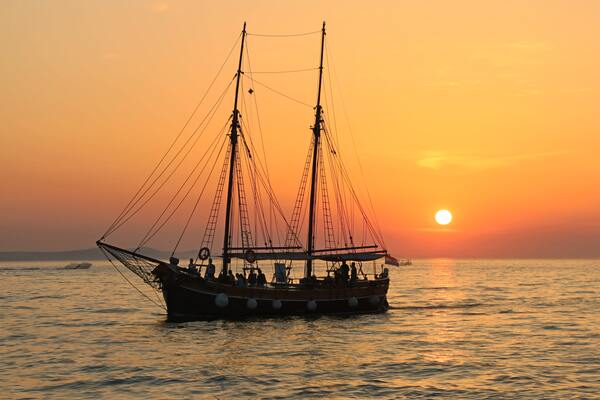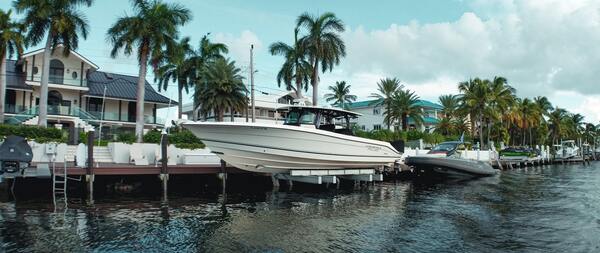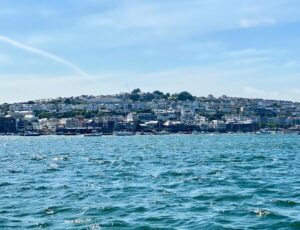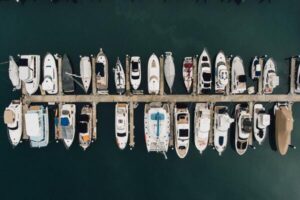How can you tell whether a boat is the best fit for you? Make the difficult but necessary decision by contrasting them with the alternatives. When we talk about deck boats, we often discuss their similarities and differences when compared to pontoons. But, it’s even more instructive to make comparisons between deck boats and bowriders.
What Are Deck Boats
The maximum passenger capacity of these boats is between 8 and 12. The length ranges from 18 to 28 feet, but 25 to 35 feet are more typical. A stern or outboard power drive is present. They are frequently used for day cruising, freshwater fishing, and other water sports. In lakes, oceans, and bays, deck boats are frequently used.
Only nice days are appropriate for using them. Deck boats, which are more recent than bowriders and are often compared to pontoon boats, are a cross between the two.
A fiberglass hull is a norm for deck boats. You can check out the Monterey brand, they do classic deck boats. These boats are a great choice if you want to “do it all” on the water. There are deck boats available that are already furnished with a topper, life jackets, and other safety gear.
Many deck boats have similar characteristics. The first is the roomy seats. Many can hold five or more people at once. The ease of boarding and disembarking a deck boat is the second characteristic you’ll notice about them.
The boat has ample storage to accommodate all of your family’s needs, whether they be for gear or snacks. They also have a shallow draft and quick on-plane stability.
These boats share a similar purpose and appearance. On top of the bowrider’s v-shaped hull, the deck boat’s wider front, or bow, is essentially a wider deck.
These two boats are both made of fiberglass and are both quick. Deck boats and bowriders are frequently compared to sports cars or minivans. Bowriders have a sleek appearance akin to a sports car, while deck boats have the hefty dependability of a minivan.
What Are Bowriders
Bowrider boats are so named because there is an option to sit up front. There are various styles.
These are some of the most well-liked powerboats for households. 16 to 35 feet is the long range. There can be up to 10 passengers.
Fishing, recreational boating, and day cruising are all popular uses for bowriders. They are employed in shallow saltwater bays, lakes, and oceans.
The bowriders’ advantages include their portability. Bowriders use boats with an open, pointed bow. Additionally, a windshield shields the cockpit. These kinds typically have a prime number of 21 or less. Bowriders that are smaller are designed for use on smaller bodies of water.
Small bowriders will have two captain’s chairs and bench seats up front, as well as a bench seat behind the cockpit. The width represents the most significant difference between brands.
Bowriders 22′ and larger are larger bowriders. This opens up more space for original layouts and designs. These can accommodate more people comfortably by having a U-shaped seating arrangement.
The Differences Between Deck Boats And Bowriders
Hull Design
The better a boat cuts through the water, the deeper the V of the hull and the narrower the bow. This implies that a boat with a deep-V hull has a faster top speed, can turn more quickly, and cuts through waves rather than slamming into them.
For a much more stable platform at the expense of overall performance, a hull with a shallower V shape and a broader, blunter bow is advantageous. However, the wider bow gives the boat more room on deck.
- Bowriders
In rougher waters, they are faster and easier to maneuver than deck boats, but less stable on flat water due to their deeper V-shaped hulls and narrower bows.
- Deck Boats
Wider bows and flatter hulls give them more stability in calmer waters but make them less useful in choppy waters.
Styling & Layout
Bowriders and deck boats primarily differ in the area of the bow. Deck boats get their name from having a large deck area up front and a wider bow area.
The amount of deck space forward of the helm is constrained by bowriders’ classic styling, which narrows to a point at the bow. Similar styling is shared by both boat types, including trim, Gelcoat colors, and graphics.
- Bowriders
Although they can be up to 35 feet long, deck boats are typically smaller—between 18 and 25 feet long. The majority use outboard motors, though some use sterndrives.

- Deck Boats
Usually bigger to accommodate the front extra deck space. can be as low as 18’, but the majority are between 25 and 35’. equally powered by sterndrives and outboard motors.
Performance
A bowrider’s hull’s traditional V shape, as previously mentioned, enhances its ability to slice through the water.
By doing so, bowriders are able to turn more quickly, travel faster, and maintain a better line of sight. In comparison to a bowrider, a deck boat’s flatter hull can’t match its high-speed performance, but it is more stable at slower speeds or when at rest.
- Bowriders
More suited to rougher environments, such as those found in large, wave-prone lakes and coastal waters.
- Deck Boats
More appropriate in calmer environments like lakes and rivers or inner coastal waters with the minimal swell.
Capacity
A deck boat’s wider beam (boat width) at the front allows it to have a larger deck, which, of course, means more space for passengers.
Comparing bowriders and deck boats of equal length, the latter can carry more people. The bigger deck area also means more storage space for personal items, safety gear, and watersports equipment beneath the decks.
- Bowriders
with enough room for everyone to move around, and easily accommodate a family of five. Up to 10 people can travel aboard larger bowriders.
- Deck Boats
provide enough room for a family of five to move around comfortably. A dozen people can travel onboard larger deck boats, though.
Watersports
Family boats are typically accompanied by watersports of some kind — wakeboarding, waterskiing, tubing, etc. Both bowriders and deck boats can tow a wakeboard or ski tower thanks to a towing eye that is fixed to the back deck or transom on both types of boats.
- Bowrider
Better performance is suitable for more seasoned wakeboarders or skiers.
- Deck Boat
A platform that is slower but more stable; better for towing a tube and for beginner wakeboarders or skiers.
Fishing
Both boat types can be used for fishing, although they don’t have the maneuverability or ability to get into extremely shallow waters like bass boats or flat boats.
- Bowriders
Although more constrained in movement, which can make fishing more difficult, the deck is better suited for sea fishing in rougher conditions.
- Deck Boats
It is simpler to move around and more appropriate for fishing in calmer waters.
Price
Because it can accommodate more people, which is desirable to buyers of family boats, a deck boat is typically more expensive than a bowrider.
- Bowriders
With lower maintenance and insurance costs, they are typically less expensive than deck boats.
- Deck Boats
The cost of ownership is typically higher than that of bowriders, as are the maintenance and insurance costs.



